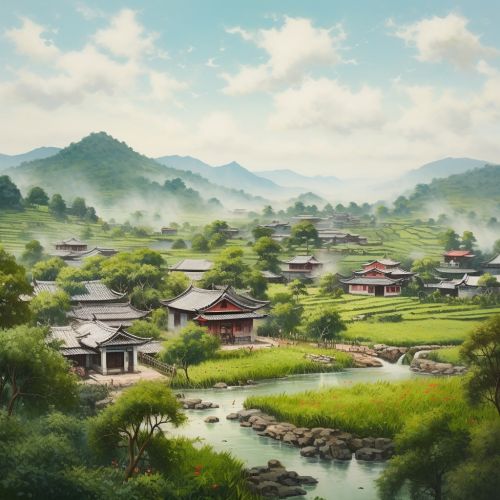Chinese village
Overview
A Chinese village is a basic rural administrative and territorial unit in China. Unlike urban cities, which possess city-level administrative status, villages are divisions of townships or county-controlled cities. The village is the lowest level of government administration in Mainland China.


History
The history of Chinese villages dates back to the Neolithic Age, when the Yangshao and Longshan cultures established village-like settlements. These early settlements were typically small, consisting of a few families living in communal structures. Over time, these settlements evolved into larger, more complex communities, reflecting the development of agricultural practices and social structures.
Structure and Administration
Chinese villages are typically structured around a central square or marketplace, with residential houses, communal facilities, and agricultural lands radiating outwards. The village administration is usually composed of a village committee, which is elected by the villagers themselves. This committee is responsible for managing the day-to-day affairs of the village, including the allocation of resources, maintenance of public facilities, and enforcement of local regulations.
Economy
The economy of Chinese villages is primarily based on agriculture, with rice, wheat, and maize being the main crops. However, in recent years, many villages have diversified their economies, incorporating industries such as small-scale manufacturing, tourism, and e-commerce. This economic diversification has been driven by a combination of government policies and market forces, and has significantly improved the living standards of many rural residents.
Culture
Chinese village culture is rich and diverse, reflecting the country's long history and diverse ethnic makeup. Traditional customs, festivals, and rituals play an important role in village life, and many villages have their own unique cultural traditions. These traditions are often closely tied to the agricultural calendar, and include practices such as ancestor worship, dragon boat racing, and the celebration of the Lunar New Year.
Challenges and Opportunities
Despite their cultural richness and economic potential, Chinese villages face a number of challenges. These include issues such as rural-urban migration, land degradation, and inadequate infrastructure. However, there are also significant opportunities for rural development, including the potential for sustainable agriculture, rural tourism, and the digital economy.
